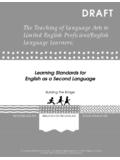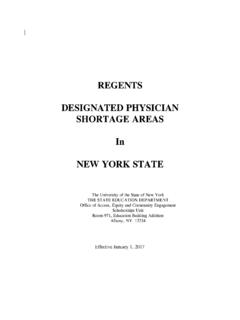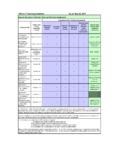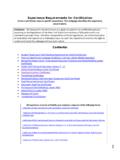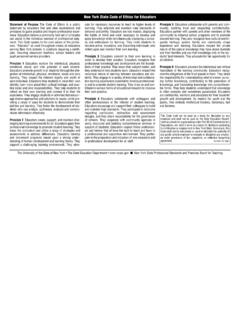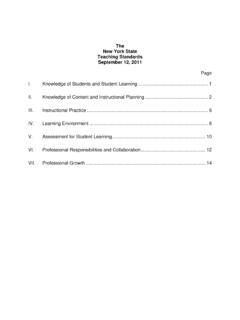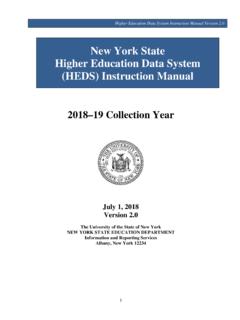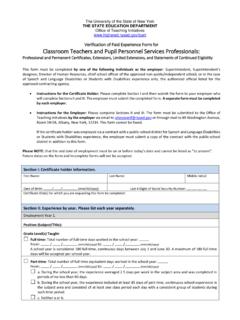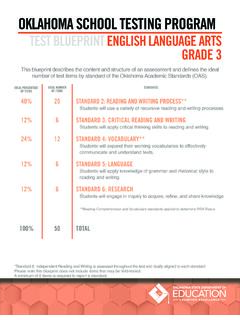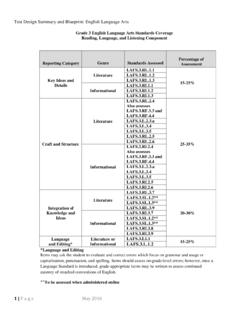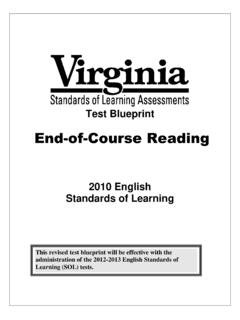Transcription of THE STATE EDUCATION DEPARTMENT / THE UNIVERSITY …
1 THE STATE EDUCATION DEPARTMENT / THE UNIVERSITY OF THE STATE OF NEW YORK / ALBANY, NY 12234 December 8, 2014 To: Deans and Directors of Institutions Offering Teacher Preparation Programs in New York STATE From: John L. D Agati, Deputy Commissioner Office of Higher EDUCATION Angelica Infante, Associate Commissioner Office of Bilingual EDUCATION and World Languages Subject: Increase in english language Learner Population and Corresponding Instructional Needs We are witnessing exciting changes to the student population of New York STATE schools, particularly those who speak languages other than english . Over the past 10 years, New York STATE english language Learner (ELL) student enrollment has increased by 20 percent. This trend is not unique to New York; according to the DEPARTMENT of EDUCATION , ELL student enrollment has increased by 18 percent nationally. Currently in New York STATE , nearly a quarter of a million ELLs make up almost 10 percent of the total public school student population, with even more ELLs enrolled in our private schools.
2 Students in New York STATE speak over 200 languages, and nearly 45 percent of ELLs were born outside of the United states . This growth has led to the creation and implementation of several initiatives by the DEPARTMENT to address the needs of ELLs. We would like to share some of the details of these initiatives with you and ask for your help in meeting the goals of these initiatives. First, as successful initiatives begin with a clear plan, the DEPARTMENT has developed the Blueprint for english language Learner Success (available on the DEPARTMENT s web site at: ). The Blueprint consists of carefully developed principles to be utilized as a statewide framework to clarify expectations and create guidance, resources and support for administrators, policymakers, districts, schools and practitioners to prepare ELLs for college and career success. The Blueprint stands in sharp contrast to the status quo, and the principles articulated in the Blueprint will fundamentally influence how ELLs are educated in New York STATE public schools.
3 These eight principles include: (i) establishing an understanding that all teachers are teachers of ELLs, and must be prepared accordingly; (ii) establishing an understanding that all school boards, together with district and school building leadership, are jointly and severally responsible for ensuring that the academic, linguistic, social, and emotional needs of ELLs are addressed; (iii) requiring grade-appropriate, academically rigorous coursework aligned to college and career readiness standards for ELLs; (iv) recognition of the inherent value in bilingualism and biliteracy, and offering such value to the entire school population; (v) recognition of the inherent value of the parents and families of ELLs; (vi) leveraging the expertise of Bilingual, ESL, and Languages Other Than english (LOTE) teachers and support personnel, and increasing the number of teachers and support staff so certified; (vii) leveraging ELL home languages and cultural assets; and (viii) using district and school level diagnostic tools and formative assessment practices in order to measure the content knowledge of the ELL population.
4 To help implement the Blueprint, the DEPARTMENT has advanced changes to the professional development (PD) requirements for teachers. At its September 2014 meeting, the Board of Regents adopted a number of changes to Commissioner s Regulation Part 154, including a new requirement that each school district provide PD to all teachers and administrators to address the needs of ELLs. Specifically, a minimum of 15 percent of the required PD clock hours for all teachers must be dedicated to language acquisition and include a focus on best practices for co-teaching strategies and integrating language and content instruction for ELLs. Further, for all Bilingual and english to Speakers of Other Languages (ESOL) teachers, a minimum of 50 percent of the required PD clock hours must be dedicated to language acquisition in alignment with core content area instruction, including a focus on best practices for co-teaching strategies and integrating language and content instruction for ELLs.
5 All school districts must also align and integrate PD for Bilingual and ESOL teachers with the PD plan for core content areas for all teachers in the district. In addition to the ELL Blueprint and the PD requirements, the DEPARTMENT has also launched the Bilingual Common Core Initiative. As a result of this initiative, the DEPARTMENT is developing, in conjunction with a national advisory group of ELL experts, New language Arts Progressions and Home language Arts Progressions for every New York STATE Common Core Learning Standard in every grade, from pre-kindergarten through grade 12. It is essential to the success of your candidates that the changes in the ELL student population in New York be accompanied by changes in instruction to ensure all P-12 students are prepared for success in college and careers. Included with each Common Core Standard for ELA, are performance indicators for each modality that demonstrate how students at each of the five levels can meet the Common Core standard for their grade level, using grade level text, with appropriate scaffolds and supports.
6 (For more information, visit ). The DEPARTMENT has also developed information regarding research-based scaffolds and routines that will assist ELLs in meeting the NYS CCLS and mastering the New York STATE Common Core english language Arts curriculum. (This information can be found at: ). The increased number of ELLs in our schools also affects the demand for teachers in New York STATE , which is the rationale for this letter. We also anticipate that many districts will respond to the recent changes to Part 154 enacted by the Board of Regents by expanding bilingual programs (including dual language programs) and by increasing team teaching of content courses at the secondary level by subject-matter teachers and ESL or bilingual teachers. Compared to the challenging employment market witnessed by some of those with other certification and extension areas, there is a current and critical need for ESOL teachers and teachers with a Bilingual extension throughout the STATE , in both large and rural districts.
7 For example, recent data indicate a 22 percent placement rate in NYS schools for newly certified elementary school teachers as opposed to a much stronger placement rate in NYS schools for newly certified teachers of english to Speakers of Other Languages. As the ELL population continues to grow, more appropriately qualified educators will be needed to meet this demand. To that end, we write to you, as our STATE s primary source of new, highly qualified educators to ask you to help us meet this demand. The robust growth in the ELL student population has led us to launch the initiatives outlined above. For districts to successfully implement these initiatives, and meet the needs of the ELLs, the STATE must immediately begin preparing more educators with not only ESOL certification, but more educators academically prepared to add the Bilingual extension. We have discussed before the importance of college and career readiness for all students; we must ensure that our ELLs have the benefit of well-prepared teachers who can help them gain the knowledge and skills necessary to succeed in college and careers.
8 The requirements to obtain the Bilingual extension to a certification area are established in of the Commissioner s Regulations. Generally speaking, for most subject areas, the candidate for a Bilingual extension must have achieved a satisfactory level of oral and written proficiency in english and the target language of instruction, and complete coursework inclusive of: (i) theories of bilingual EDUCATION and multicultural perspectives; (ii) sociolinguistics and psycholinguistics; (iii) methods of teaching english language arts and native language arts to bilingual ELLs using the native language and english ; and (iv) methods of teaching other content to bilingual ELLs using the native language and english . Encouraging your candidates to seek ESOL certification or a Bilingual extension serves the greater good in many different ways. The benefits to the rapidly expanding ELL student population in New York STATE are plainly self-evident; however, the benefits extend to your programs and your candidates as well.
9 As a result of the Blueprint, the Bilingual Common Core Initiative, the newly adopted PD requirements precipitated by the growing ELL student population, and the need for ESOL educators and educators with a Bilingual extension has never been greater. While educators, particularly newly certified educators, have faced an increasingly challenging job market in New York STATE , all indications are that educators with ESOL certification and the Bilingual extension will have far better career prospects in New York STATE schools than will their peers without these credentials. Higher placement rates, coming part and parcel with appropriate academic preparation to help ELLs reach college and career readiness standards, offers clear programmatic benefit in their own respect as both candidates and the DEPARTMENT evaluate programs, in part, based on the number of candidates placed in teaching positions following graduation.
10 As we have outlined above, increasing the number of educators appropriately prepared and credentialed to teach ELLs is a win-win-win prospect. Newly certified teachers will find more job opportunities; programs will enjoy higher placements rates; and, critically, ELLs in New York STATE will be provided with world-class instruction tailored to their unique needs necessary to prepare them for success in college and careers in the global economy. Thank you for your assistance with this important matter.
